It stands as a fading sentinel of the Midwest. It saw the dawn of the 20th century, standing at the beginning of an era when farmers upgraded from the humble homesteading shack to two-story clapboard houses, claiming the prairie as their home. It weathered the Great Depression, two world wars and the shifting of agriculture from horsepower to John Deere and Case power. It witnessed the tide of people rolling in and settling the countryside. And as the years have progressed, it’s witnessed that tide ebbing out, people moving away as farming has become more efficient, requiring fewer and fewer men to accomplish what once required many.
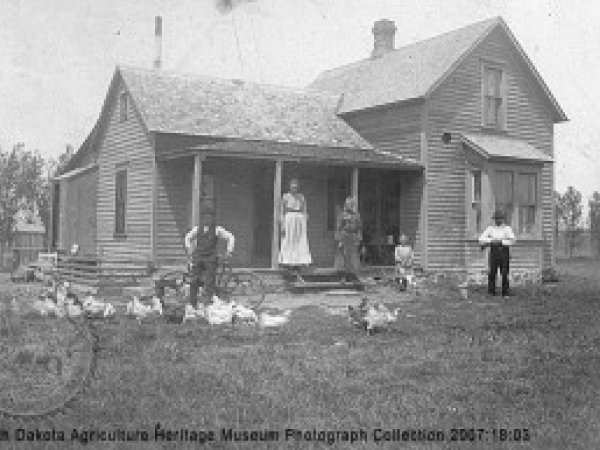
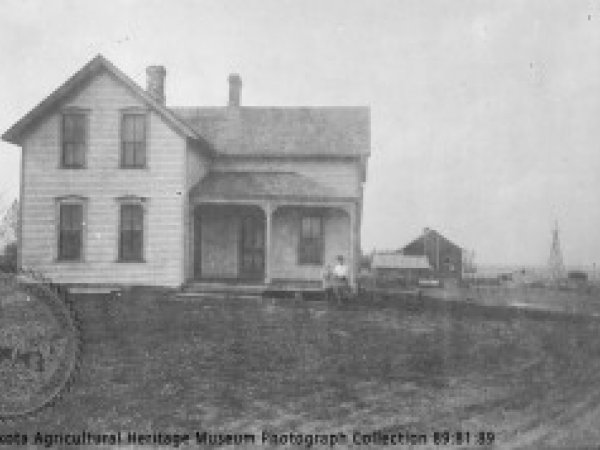
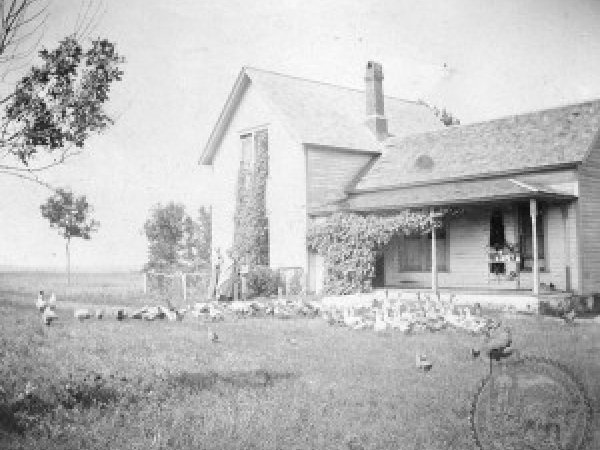
So reigns the legacy of the American farmhouse.
The 1915 farmhouse replica on exhibit at the South Dakota Agricultural Heritage Museum gives a glimpse back in time to what the early 20th century farmhouse looked like. Generally one and a half to two stories in height, structured in an L- or T-shape from a bird’s eye view, the typical farmhouse often sported an open or screened porch. Many were white with red, green or black trimmed storm windows and screens.
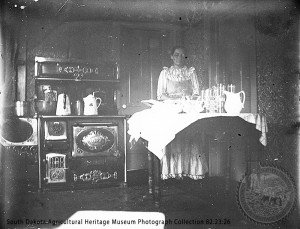
For those looking back on the days and years spent in that early 20th century farmhouse, many of the warmest memories focus on the kitchen. The kitchen was the hub that the spokes of family life spun around. The three most important times of the day – breakfast, dinner and supper – were prepared in the kitchen, bringing the family together from the various labors that occupied them throughout the day.
“The kitchen was the center of the house, no matter what its location,” says Edie French.
The kitchen “was in essence an all-purpose room,” as so aptly described by Bob Artley in his book "Memories of a Farm Kitchen." It served as the laundry room on washday, a brooder and incubator when it was time to hatch chickens and a nursery for bringing in newborn baby animals such as piglets, baby calves or lambs to keep them warm when the weather was vicious outside.
The kitchen also doubled as the parlor when needed, where “deals were cast farmer-to-farmer with feet elevated up on the cob box,” says Carol J. Peterson. When visitors came to call, they were served their tea at the kitchen table.
Homework was done in the kitchen at the table. Records, taxes and letters were all birthed at the kitchen table that served as the office where the business and bookkeeping of the family farm was managed. Baths were taken in front of the cook stove. Even the medical dispensary was sourced in the kitchen.
“During the era when a call on our fourteen-party telephone line would bring the doctor to our house—sometimes over muddy or snow-blocked roads, unless we were sick in bed, it was in the kitchen where he attended to our needs,” recalls Artley.
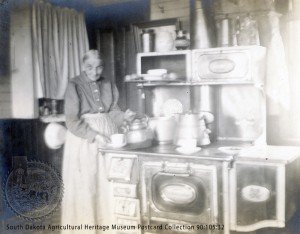
The kitchen, the central feature of the farmhouse, was open and hospitable. The all-important large cook stove was always accompanied by the cob basket or cob box. Depending on how much of a footprint modernization had made, there might be a sink with a hand pump, bringing cold water straight from the cistern. While built-in cupboards hadn’t made a significant debut yet, a free-standing Hoosier-type cabinet, China hutch or drop front oak secretary were common kitchen accessories. Sometimes a single built-in pine cabinet was used. There was the typical round oak kitchen table and perhaps a rocking chair in the corner. Shelves or hooks on the wall created more space to store kitchen utensils.
While the range, or cook stove, was essential in cooking meals and creating warmth during the wintertime, it was an unwelcome source of heat during the summer when heat was already an issue and fans were still an illusion of the future, as electricity hadn’t yet been introduced to the farm. Most farmwives had a smaller kerosene stove brought out from winter storage during the hot months and cooked meals on the back porch to prevent heating up the kitchen. The range could then be covered with newspapers and used as another workstation.
The pantry was an important extension of the kitchen. Lined with shelves, it housed the overflow from the kitchen, including tinware, kettles, baking tins, spices, bread, mixing spoons, hand towels, the cookie jar, as well as many kitchen wares.

The cellar, while effectively no more than a hole in the ground with a dirt floor and dirt or stone walls, was ideal for storing canned goods or even fresh apples and potatoes. The attic, while used for storage, was also a good place to dry and cure meat from the rafters.
The back porch or the mudroom held the spillover from the household and the outdoors on the farm. Boots, overshoes, work coats, overalls, lanterns, house lamps, separator oil, household appliances not used everyday including the washing machine, wringer and tubs and the summertime kerosene burner were among many of the items that could be found when passing through this part of the farmhouse.
Bedrooms and a living area or parlor often completed the structure of the farmhouse.
Down Home Memories
“Many of the best memories of my childhood home center on the iron cook stove sitting at one side of the big square farmhouse kitchen. Mama kept its pale green enameled sides and black cook top spotless and gleaming. The reservoir on one end had become rusty, so we didn’t use it to heat water for cooking, but there was always water in it. Attached to the top of the metal sheet extending upward from the back of the cook top was a warming shelf, the perfect place for storing crackers to keep them crisp. It also held a pile of hot pads and the large green glass salt and pepper shakers with their dented tin tops.
We burned dry corn cobs in the stove most of the time, and keeping the cob box filled was a job for us children. Every day after school, out we’d go, bundled up in flannel shawls over our heads, warm coats and heavy gloves. After we’d filled the galvanized tub to the top, we’d stick in a row of cobs upright around the rim so we could add another four or five inches of cobs. By the time we were done, we’d be a bit warmer already.
Warmth radiated out from the cook stove, doing a pretty good job of heating the entire kitchen, but I was always warmest right next to it. Sometimes, in the morning before the stove could even begin to warm the kitchen, Mama would allow us to open the oven door and lean on it to get warmed up after coming in from milking the cows.
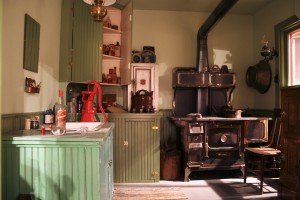
I can still smell the soups simmering at the back of the stove on cold winter days and Mama’s fried chicken, which needed to be cooked near the front of the stove where the fire made the surface the hottest. But nothing ever tasted as good as a slice of Mama’s homemade bread, toasted directly over the hot coals in the firebox. No modern toaster can even come close to that flavor.
Whether it was bathing on Saturday nights with the tub sitting right beside the stove or pulling the kitchen table a little closer to it to play board games, those wonderful times of a family cozily interacting in a kitchen heated by a big old stove still warm my memories.”
Marily Kratz, Bon Homme County, SD
“Growing up during the Depression was tough times. We didn’t have a lot and couldn’t afford to burn fuel to heat the whole house during the winter, so we’d close off the rest of the house and live in the kitchen all winter. Cooking, eating, sleeping, you name it, we spent it all in the kitchen. You get to know each other mighty well when you spend 24 hours seven days a week crammed into one small room with four other people!”
Duane Beck
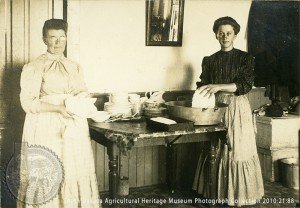
“The kitchen is the most important room in the house. More than that, it is one of the most important because it is there that the materials are prepared which are to build the strong and healthy men and women of our country.”
Miss H. Mae Card, Dakota Farmer 1907
“What was characteristic of these old farmhouses? First and foremost was the large roomy hospitable kitchen. The household activities centered around this kitchen.”
Carol J. Peterson
“It was the range, with its nearby stack of split wood, a coal bucket and a pail full of corncobs, that made it a farm kitchen, with all the ambiance that suggests. The farm kitchen of the 1920's and 1930's was not only a place; it was an environment where the culture of farm life was nurtured.”
Bob Artley, Memories of a Farm Kitchen
by Erin Beck, Museum Intern 2014
Sources
Artley, Bob and Rob. Memories of a Farm Kitchen. Pelican Publishing Company. Gretna, Louisiana. 2010.
Artley, Bob. Once Upon a Farm. Bob Artley. Pelican Publishing Company. Gretna, Louisiana. 2000.
Cunningham, Ray. “Rural Living at the Turn of the Century.” South Dakota Agricultural Heritage Museum Collection. 1976.
French, Edie. “Early Dakota Farmhouse Kitchens.” South Dakota Agricultural Heritage Museum Collection.
Hublou, Lynn B. “Dreams of a New Beginning and Dreams of a Bountiful Harvest.” South Dakota Agricultural Heritage Museum Collection. 1987.
Miller, John E. Life on the Farm and Ranch: South Dakota Stories. South Dakota Humanities Council. Brookings, South Dakota. 2009.

